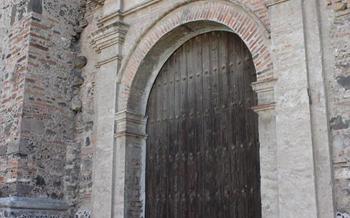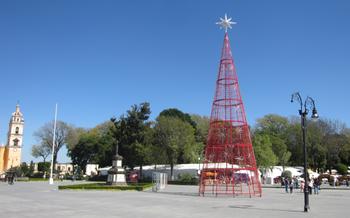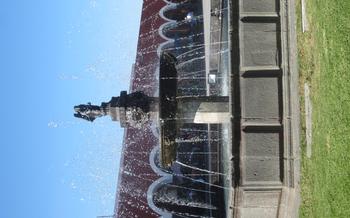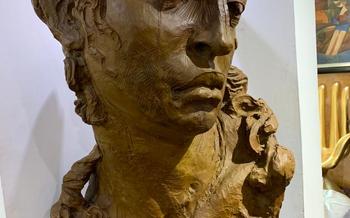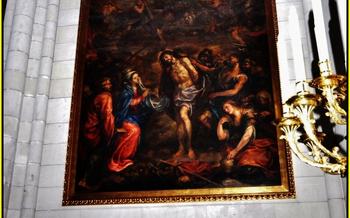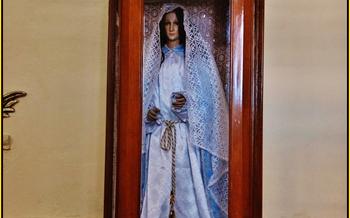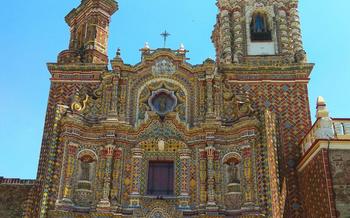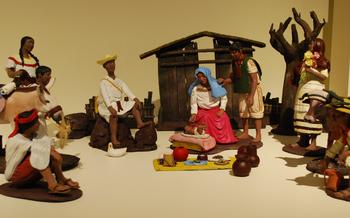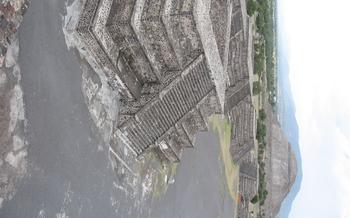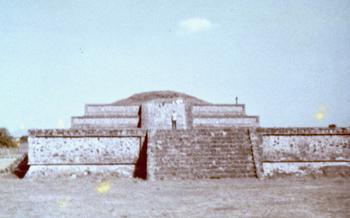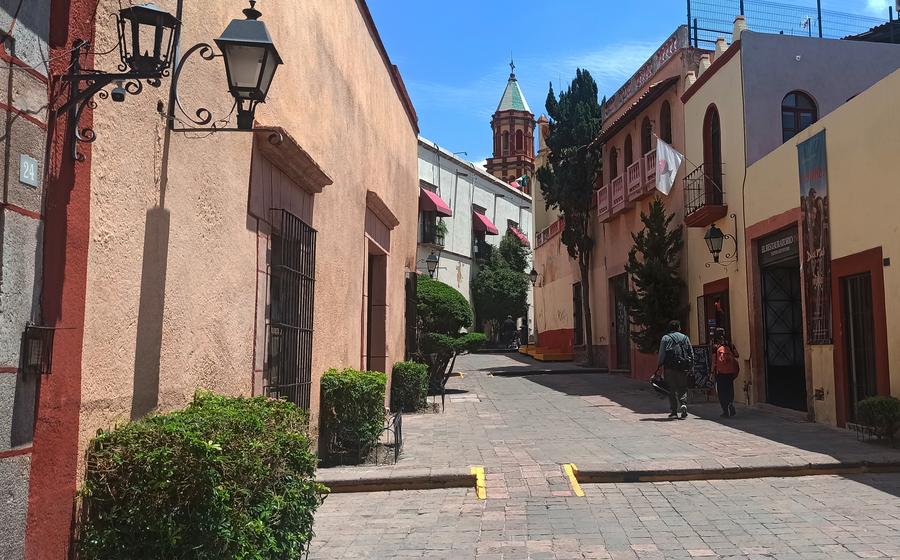
La Cañada de la Virgen Archaeological Site
- The La Cañada de la Virgen Archaeological Site: A Historicalmi people, who inhabited the region from around 500 BCE to 1500 CE. At its peak, the city covered an area of over 80 hectares and was home to an estimated 20,000 people.
- Getting to the La Cañada de la Virgen Archaeological Site
- Exploring the La Cañada de la Virgen Archaeological Site: A Step-by-Step Guide
- The Great Pyramid of La Cañada de la Virgen: An Architectural Marvel
- The Pyramid of the Niches: A Masterpiece of Ancient Art
- The Ballcourt: A Place of Ritual and Sport
- The Museo de la Zona Arqueológica de La Cañada de la Virgen: A Treasure Trove of Artifacts
- The La Cañada de la Virgen Archaeological Site: A Place of Natural Beauty
- The People of La Cañada de la Virgen: A Living Legacy
- The La Cañada de la Virgen Archaeological Site: A World Heritage Site
- The La Cañada de la Virgen Archaeological Site: A Site of Ongoing Research
- The La Cañada de la Virgen Archaeological Site: A Place of Mystery and Intrigue
- The La Cañada de la Virgen Archaeological Site: A Place of Spiritual Significance
- The La Cañada de la Virgen Archaeological Site: A Place of Inspiration
**The La Cañada de la Virgen Archaeological Site: A Historicalmi people, who inhabited the region from around 500 BCE to 1500 CE. At its peak, the city covered an area of over 80 hectares and was home to an estimated 20,000 people.
Importance of the site:
La Cañada de la Virgen is one of the most important archaeological sites in central Mexico. It is one of the few sites where Otomi culture and history can be studied in depth and provides valuable insights into the lives and customs of this ancient civilization.
Major archaeological discoveries:
Some of the most significant archaeological discoveries at La Cañada de la Virgen include the Great Pyramid, the Pyramid of the Niches, and the ballcourt. These structures provide evidence of the Otomi people's advanced knowledge of architecture, engineering, and city planning. The site also contains a large number of residential structures, workshops, and storage facilities, providing a glimpse into the everyday lives of the Otomi people.
Getting to the La Cañada de la Virgen Archaeological Site
The La Cañada de la Virgen Archaeological Site is situated in the municipality of Cadere.
The site is open to the public daily from 9:00 AM to 5:00 PM. The entrance fee is $75 pesos for adults and $50 pesos for children. Guided tours are available for an additional fee.
Several transportation options are available for those without a vehicle. Buses depart regularly from Querétaro City and San Luis Potosí to Cadereyta de Montes, where you can catch a taxi or local bus to the archaeological site. Alternatively, you can hire a private taxi or tour guide to take you directly to the site.
Exploring the La Cañada de la Virgen Archaeological Site: A Step-by-Step Guide
The La Cañada de la Virgen Archaeological Site is a sprawling complex, and exploring it thoroughly requires careful planning. The site is divided into several areas, each with its unique attractions. The layout of the site is designed to guide visitors through the different areas in a logical sequence.
Start your exploration with the Great Pyramid, the most impressive structure on the site. Climb the steps to the top of the pyramid for panoramic views of the surrounding landscape. Next, visit the Pyramid of the Niches, which is renowned for its intricate carvings. Be sure to take your time to examine the details of the carvings, as they provide valuable insights into the culture and beliefs of the ancient people who built this site.
Don't miss the Ballcourt, a large open area where ancient Mesoamericans played a ritual ball game. Imagine the excitement and energy that must have filled the air during these games. The Museo de la Zona Arqueológica de La Cañada de la Virgen is a must-visit for anyone interested in learning more about the history and culture of the site. The museum houses a collection of artifacts that have been excavated from the site, including pottery, figurines, and tools. Take your time to explore the exhibits and gain a deeper understanding of the ancient civilization that once flourished here.
The Great Pyramid of La Cañada de la Virgen: An Architectural Marvel
Amidst the archaeological wonders of La Cañada de la Virgen, the Great Pyramid stands tall, a testament to the ingenuity and architectural prowess of ancient civilizations. Towering over the surrounding landscape, this colossal structure is the largest pyramid at the site and one of the most impressive in the region.
Measuring an astounding 28 meters in height and boasting a base of 70 meters on each side, the Great Pyramid dwarfs the other structures at La Cañada de la Virgen. Its sheer size and imposing presence are awe-inspiring, leaving visitors in a state of wonder and admiration.
The pyramid's architectural features are equally remarkable. Constructed using large blocks of stone, the pyramid exhibits a precision and symmetry that is characteristic of ancient Mesoamerican architecture. The exterior is meticulously finished with a smooth, plaster-like coating, giving it a sleek and polished appearance.
One of the most striking features of the Great Pyramid is its steep slope, which is unusual among Mesoamerican pyramids. This steep inclination creates a sense of height and grandeur that is further accentuated by the pyramid's imposing dimensions.
The Great Pyramid of La Cañada de la Virgen is not only an architectural marvel but also a testament to the advanced engineering skills of ancient civilizations. Its construction required meticulous planning, coordination, and a deep understanding of structural principles. The pyramid's enduring legacy stands as a symbol of the ingenuity and creativity of the people who built it.
The Pyramid of the Niches: A Masterpiece of Ancient Art
The Pyramid of the Niches, also known as the Temple of the Niches, is one of the most striking and iconic structures at the La Cañada de la Virgen Archaeological Site. Its name derives from the numerous niches that adorn its façade, each of which once held a statue of a deity. These niches are arranged in seven rows, with four niches in the upper row and 13 niches in each of the remaining rows.
The carvings on the Pyramid of the Niches are exquisite and intricate, depicting a variety of deities, animals, and other symbols. The most prominent deity depicted is Tláloc, the rain god, who is shown with his characteristic goggle eyes and headdress. Other deities represented include Quetzalcoatl, the feathered serpent god, and Xipe Totec, the god of spring and agriculture.
The symbolism of the carvings on the Pyramid of the Niches is complex and multifaceted. Some scholars believe that the niches represent the different levels of the cosmos, while others believe that they symbolize the different stages of the agricultural cycle. The carvings also provide valuable insights into the religious beliefs and practices of the ancient people who built the pyramid.
The Ballcourt: A Place of Ritual and Sport
Amidst the ancient ruins of La Cañada de la Virgen, the ballcourt stands as a testament to the cultural significance of sports in ancient Mesoamerican society. This large, rectangular court, with its sloped sides and stone markers, was the stage for a ritualized ball game that held both religious and social importance.
The rules of the game, known as "tlachtli," were complex and varied from region to region. However, the general objective was for players to keep a solid rubber ball in play using their hips, elbows, and knees, while avoiding hitting it with their hands or feet. The ball could be bounced off the walls of the court, but it was forbidden to touch the ground.
Tlachtli was more than just a game; it was also a ritual and a form of entertainment. The matches were often played during religious festivals and were accompanied by music, dance, and feasting. The outcome of the game was believed to have supernatural significance, and the winning team was often rewarded with prestige and honor.
The ballcourt at La Cañada de la Virgen is a particularly impressive example of this ancient Mesoamerican tradition. Its large size and elaborate construction suggest that it was used for important matches and ceremonies. The court is also notable for its well-preserved stone markers, which indicate the boundaries of the playing field and the positions of the players.
Visiting the ballcourt at La Cañada de la Virgen is a fascinating way to learn about the cultural and religious significance of sports in ancient Mesoamerican society. This ancient arena offers a glimpse into a world where competition, ritual, and entertainment were intertwined.
The Museo de la Zona Arqueológica de La Cañada de la Virgen: A Treasure Trove of Artifacts
The Museo de la Zona Arqueológica de La Cañada de la Virgen is a must-visit attraction for anyone interested in the history and culture of the ancient civilizations that inhabited the region. The museum houses a vast collection of artifacts excavated from the archaeological site, providing visitors with a unique opportunity to learn more about the daily lives, beliefs, and practices of the people who lived here centuries ago.
The exhibits on display at the museum include pottery, jewelry, tools, weapons, and sculptures. Each artifact tells a story about the people who created and used it, offering a glimpse into their technological advancements, artistic traditions, and social structures. The museum also features interactive displays and multimedia presentations that help visitors understand the significance of the artifacts and the context in which they were found.
One of the highlights of the museum is the collection of ceramic figurines, which depict a wide range of human and animal forms. These figurines provide valuable insights into the religious beliefs and artistic styles of the ancient inhabitants of La Cañada de la Virgen. The museum also houses a collection of stone sculptures, including some that were once part of the pyramid temples. These sculptures showcase the remarkable skill and craftsmanship of the ancient artisans.
The Museo de la Zona Arqueológica de La Cañada de la Virgen is an essential destination for anyone who wants to learn more about the rich history and culture of this ancient archaeological site. The museum's collection of artifacts, interactive displays, and multimedia presentations provide visitors with a comprehensive understanding of the people who lived here and the legacy they left behind.
The La Cañada de la Virgen Archaeological Site: A Place of Natural Beauty
The La Cañada de la Virgen Archaeological Site is not only a place of historical and cultural significance but also a place of extraordinary natural beauty. The site is situated in a stunning landscape, characterized by rolling hills, lush vegetation, and diverse wildlife. Visitors can take advantage of the numerous trails that wind through the site, offering breathtaking views of the surrounding countryside. The site is also home to a variety of plants and animals, making it a great place for nature enthusiasts and birdwatchers. Visitors can spot a variety of birds, including hummingbirds, parrots, and eagles, as well as a variety of other wildlife, such as deer, rabbits, and squirrels. Whether you're a nature lover, an avid hiker, or simply someone who appreciates the beauty of the natural world, the La Cañada de la Virgen Archaeological Site has something to offer. Take some time to explore the site's natural wonders, and you'll be rewarded with stunning views, fresh air, and a chance to connect with the beauty of the Mexican countryside.
The People of La Cañada de la Virgen: A Living Legacy
The La Cañada de la Virgen Archaeological Site is not just a place of ancient ruins; it is also a place where the living legacy of ancient cultures can still be felt. Indigenous communities, such as the Otomí and Nahua peoples, have lived in the area for centuries, and their traditions and way of life are closely intertwined with the archaeological site.
The local people have a deep respect for the ancient ruins and consider them to be sacred places. They often visit the site to conduct ceremonies and rituals, and they have a wealth of knowledge about the history and significance of the site.
Tourists who visit the La Cañada de la Virgen Archaeological Site can learn a great deal from the local people. By interacting with them, tourists can gain a deeper understanding of the ancient cultures that built the site, as well as the modern-day traditions of the indigenous communities who live in the area.
The La Cañada de la Virgen Archaeological Site: A World Heritage Site
Recognition by UNESCO
The La Cañada de la Virgen Archaeological Site holds a prominent place on the list of UNESCO World Heritage Sites. This prestigious designation was bestowed upon the site in 1997, recognizing its exceptional universal value and cultural significance. The site's inclusion on this prestigious list reflects its status as an irreplaceable repository of human history and heritage.
Criteria for Inclusion on the World Heritage List
To be considered for inclusion on the World Heritage List, a site must meet at least one of ten selection criteria established by UNESCO. The La Cañada de la Virgen Archaeological Site satisfies several of these criteria. It represents a unique and outstanding example of a well-preserved pre-Columbian city, showcasing the engineering prowess and artistic achievements of its ancient inhabitants.
Importance of Preserving the Site
The recognition of the La Cañada de la Virgen Archaeological Site as a World Heritage Site underscores the importance of preserving this extraordinary legacy for future generations. UNESCO's designation emphasizes the need to protect and conserve the site, ensuring its integrity and authenticity for the benefit of humanity.
The La Cañada de la Virgen Archaeological Site: A Site of Ongoing Research
The La Cañada de la Virgen Archaeological Site is not just a relic of the past but also a place where the past continues to be uncovered and understood. Active archaeological excavations and studies are ongoing at the site, led by teams of experts from various institutions. These investigations aim to shed light on the history, culture, and daily lives of the ancient people who inhabited this region.
Recent excavations have unearthed new artifacts, structures, and features that provide valuable insights into the site's past. For example, the discovery of a large number of obsidian tools suggests the presence of a specialized workshop where these tools were produced. The identification of new plazas, patios, and residential areas has helped archaeologists understand the site's layout and social organization.
The ongoing research at La Cañada de la Virgen is not limited to archaeological excavations. Scholars from various disciplines, including anthropologists, historians, and art historians, are engaged in interdisciplinary studies to gain a comprehensive understanding of the site. These studies focus on topics such as the site's economic system, religious beliefs, political organization, and cultural interactions with other regions.
The ongoing research at La Cañada de la Virgen is essential for preserving and interpreting the site's heritage. It helps to fill in the gaps in our knowledge and bring to light new perspectives on the ancient civilization that once thrived here. The findings from these investigations are shared through publications, conferences, and public outreach programs, ensuring that the legacy of La Cañada de la Virgen continues to be studied, appreciated, and shared with the world.
The La Cañada de la Virgen Archaeological Site: A Place of Mystery and Intrigue
The La Cañada de la Virgen Archaeological Site is shrouded in an air of mystery and intrigue, fueling the imaginations of visitors and researchers alike. Unexplained phenomena, local legends, and ancient prophecies intertwine, creating a captivating narrative that adds to the site's allure.
One of the most intriguing aspects of the site is the presence of strange lights and sounds. Visitors have reported seeing orbs of light floating through the air, particularly at night. Unexplained noises, such as whispers and footsteps, have also been heard, adding to the eerie atmosphere.
Local legends and folklore further contribute to the site's mystique. According to one tale, the pyramid was built by a giant who possessed magical powers. Another legend speaks of a hidden treasure buried beneath the pyramid, guarded by spirits who protect it from intruders.
The site is also linked to ancient prophecies, particularly those associated with the end of the world. Some believe that the pyramid holds secrets that will reveal the fate of humanity. These prophecies have drawn many visitors to the site, hoping to gain insight into the future.
The combination of unexplained phenomena, local legends, and ancient prophecies creates a palpable sense of mystery and intrigue at the La Cañada de la Virgen Archaeological Site. Visitors are left to wonder about the true nature of these occurrences, adding a layer of fascination to their exploration of this ancient and enigmatic place.
The La Cañada de la Virgen Archaeological Site: A Place of Spiritual Significance
The La Cañada de la Virgen Archaeological Site holds immense spiritual significance for both ancient cultures and modern-day visitors. For the pre-Hispanic peoples who inhabited the region, the site was considered a sacred place, a nexus between the earthly and spiritual realms. They believed that the site possessed inherent energy and power, and they performed rituals and ceremonies to honor their gods and ancestors.
In present times, many people visit the site to experience its spiritual energy and connect with the ancient cultures that once flourished there. Some visitors participate in guided meditations or yoga sessions, while others simply sit in silence and soak in the site's tranquil atmosphere. The site's connection to spirituality is palpable, and it is not uncommon for visitors to feel a sense of peace and tranquility as they explore its ancient ruins.
The La Cañada de la Virgen Archaeological Site continues to play a vital role in the spiritual lives of local people. Many indigenous communities living near the site maintain deep connections to their ancestral traditions, and they often visit the site to perform rituals and ceremonies, seeking guidance and protection from their ancestors. The site's spiritual significance is a testament to its enduring power and its ability to inspire and uplift those who visit it.
The La Cañada de la Virgen Archaeological Site: A Place of Inspiration
The La Cañada de la Virgen Archaeological Site has served as a source of inspiration for artists, writers, and musicians throughout history. Its impressive architecture, intricate carvings, and rich cultural significance have captivated the imaginations of creative minds for centuries. Famous Mexican muralist Diego Rivera was particularly inspired by the site, incorporating elements of its iconography into his own works. The site's unique atmosphere and powerful energy have also influenced contemporary artists, leading to the creation of thought-provoking and visually stunning pieces that explore the site's cultural and historical significance.
Moreover, the La Cañada de la Virgen Archaeological Site has played a pivotal role in shaping Mexican identity. Its enduring legacy and connection to the country's pre-Columbian past have contributed to a sense of national pride and cultural heritage. The site serves as a reminder of Mexico's rich and diverse history, inspiring Mexicans to embrace their cultural roots and celebrate their unique identity.
The La Cañada de la Virgen Archaeological Site also holds the potential to inspire future generations. Its captivating history, awe-inspiring architecture, and profound cultural significance make it an ideal destination for educational and cultural trips. By visiting the site, young people can learn about Mexico's ancient civilizations, appreciate the beauty and complexity of their artistic expressions, and develop a deeper understanding of their cultural heritage. The site's ability to inspire and educate future generations ensures that its legacy will continue to live on for many years to come.
